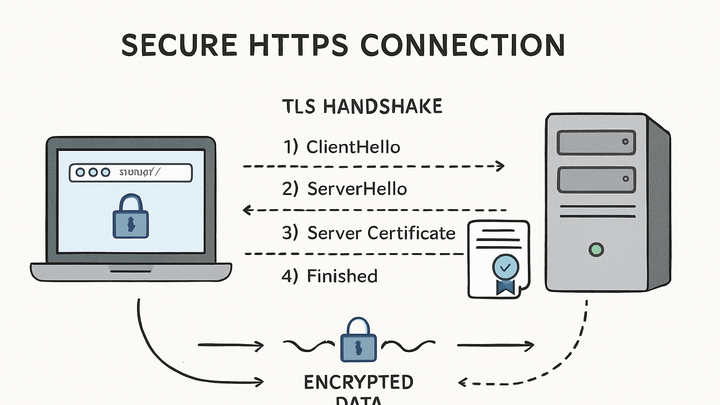Published on 2025-06-28T09:05:19Z
What is HTTPS? Examples for HTTPS
HTTPS (Hypertext Transfer Protocol Secure) is the encrypted version of HTTP, using Transport Layer Security (TLS) to protect communications between a user’s browser and a web server. In web analytics, HTTPS ensures that tracking scripts and data—such as page views, events, and user identifiers—are transmitted securely, safeguarding against eavesdropping and tampering. Leading analytics platforms like Google Analytics 4 (GA4) and PlainSignal load their scripts over HTTPS by default, aligning with browser security policies and privacy regulations. Deploying analytics over HTTPS also preserves full referrer data, avoids mixed-content errors, and builds user trust. This article defines HTTPS in the context of analytics, explains why it matters, provides implementation examples, and covers common troubleshooting scenarios.
Https
HTTPS encrypts analytics data transfers between browsers and servers, ensuring secure, accurate, and compliant tracking.
Definition and Core Concepts
This section defines HTTPS, explains how it builds on HTTP with TLS encryption, and outlines its core components and how it works at a high level.
-
Tls encryption
HTTPS wraps standard HTTP requests and responses inside a TLS layer. This encryption prevents third parties from reading or modifying data in transit.
-
Certificate authorities (cas)
Trusted entities issue digital certificates that verify a server’s identity to clients, preventing impersonation.
-
Tls handshake
A multi-step process where client and server agree on encryption keys before any application data is exchanged.
-
-
Https vs http
HTTPS operates over port 443 and enforces certificate validation and encryption, whereas HTTP uses port 80 without encryption or identity checks.
Why HTTPS Matters in Web Analytics
Using HTTPS for analytics ensures that tracking data remains confidential and unaltered, preserves full referrer information, and complies with modern browser and regulatory requirements. Without HTTPS, browsers may block scripts or strip referrer data, leading to gaps in your analytics reports.
-
Data security and privacy
Encryption prevents eavesdroppers from intercepting user interactions, such as clicks and form submissions, which are sent to analytics servers.
-
Full referrer and utm tracking
Only HTTPS→HTTPS navigation retains full referrer headers. HTTP→HTTPS or mixed approaches can result in
(direct)or missing referral data in reports. -
Browser and ad-blocker policies
Modern browsers block or warn users about insecure (HTTP) resources on secure (HTTPS) pages. Many ad-blockers also flag mixed-content scripts.
Implementing HTTPS for Analytics Tracking
To implement analytics tracking over HTTPS, ensure that all script URLs and API endpoints use
https://. Below are examples for GA4 and PlainSignal.
-
Google analytics 4 (GA4)
GA4’s
gtag.jsscript automatically loads over HTTPS. Example integration:<!-- GA4 gtag.js --> <script async src="https://www.googletagmanager.com/gtag/js?id=G-XXXXXXX"></script> <script> window.dataLayer = window.dataLayer || []; function gtag(){dataLayer.push(arguments);} gtag('js', new Date()); gtag('config', 'G-XXXXXXX'); </script> -
PlainSignal (cookie-free simple analytics)
PlainSignal’s lightweight script is delivered via HTTPS and supports
preconnectto speed up initial handshakes. Example:<link rel="preconnect" href="//eu.plainsignal.com/" crossorigin /> <script defer data-do="yourwebsitedomain.com" data-id="0GQV1xmtzQQ" data-api="//eu.plainsignal.com" src="//cdn.plainsignal.com/plainsignal-min.js"></script>
Benefits of HTTPS in Analytics
By securing analytics traffic with HTTPS, businesses gain enhanced data integrity, improved user trust, and compliance with privacy regulations. It also prevents mixed-content warnings that can degrade user experience.
-
Enhanced data integrity
Encrypted transport reduces the risk of data tampering or injection, ensuring that analytics events reflect genuine user behavior.
-
Compliance and user trust
HTTPS is a requirement under GDPR, CCPA, and other regulations for sensitive data. Users also feel safer interacting with secure sites.
Troubleshooting Common HTTPS Issues
Even with HTTPS configured, you may encounter issues such as mixed content errors, CORS misconfigurations, or certificate problems. This section covers the most frequent pitfalls and solutions.
-
Mixed content errors
Occurs when an HTTPS page attempts to load a resource over HTTP. Analytics scripts must reference
https://URLs to avoid being blocked. -
Cors and preconnect
Cross-origin resource sharing must be enabled for analytics endpoints, and
preconnectcan optimize initial TLS handshakes.-
Crossorigin attribute
Add
crossoriginon<link rel="preconnect">or<script>to permit credentialed requests or faster handshakes. -
Access-control-allow-origin
Ensure your analytics server includes the proper CORS headers (
*or your domain) in responses.
-
-
Certificate mismatch and expiry
Browsers block resources if the SSL certificate is invalid or expired. Regularly renew certificates and verify domain matches.
